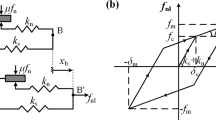Abstract
Rubbers are commonly used in industry to reduce vibration transfer and, consequently, reduce structural noise. The vibration transfer through rubber can be modelled with finite elements; however, to achieve satisfactory results it is necessary to know the viscoelastic properties of the rubber. This paper describes the commonly used theory of vibration transmission through rubber modelled as a single-degree-of-freedom (SDOF) system. Three simplified rubber models are used to identify the constant Young’s modulus and damping factor from the measurements of two different rubber specimens, and with the obtained results the theoretical transmissibilities are calculated. The frequency-dependent Young’s modulus and damping factor are also calculated from measurements. The practical use of previous measurements of dynamic material properties is presented in a finite-element analysis, where three different definitions of the dynamic material properties are carried out for four different rubber specimens, which corresponds to 12 analyses. The finite-element analyses are then compared with the measurements, and general guidelines for using dynamic material properties in ANSYS Workbench v.14 are given.
Similar content being viewed by others
References
Nashif, A.D., Jones, D.I.G., and Henderson, J.P., Vibration Damping, John Wiley and Sons, New York (1985).
Ferry, J.D., Viscoelastic Property of Polymers, Wiley, New York (1970).
Sim, S., and Kim, K.J., “A Method to Determine the Complex Modulus and Poisson’s Ratio of Viscoelastic Materials from Fem Applications,” Journal of Sound and Vibration 141(1): 71–82 (1990).
Ramorino, G., Vetturi, D., Cambiaghi, D., Pegorett, A., and Ricco, T., “Developments in Dynamic Testing of Rubber Compounds: Assessment of Non-Linear Effects,” Polymer Testing 22: 681–687 (2003).
Caracciolo, R., and Giovagnoni, M., “Frequency Dependence of Poisson’s Ratio using the Method of Reduced Variables,” Mechanics of Materials 24: 75–85 (1996).
Caracciolo, R., Gasparetto, A., and Giovagnoni, M., “Application of Causality Check and of the Reduced Variabled Method for Experimental Determination of Young’s Modulus of a Viscoelastic Material,” Mechanics of Materials 33: 693–703 (2001).
Lin, T.R., Farag, N.H., and Pan, J., “Evaluation of Frequency Dependent Rubber Mount Stiffness and Damping by Impact Test,” Applied Acoustics 66: 829–844 (2005).
Ooi, L.E., and Ripin, Z.M., “Dynamic Stiffness and Loss Factor Measurement of Engine Rubber Mount by Impact Test,” Materials and Design 32: 1880–1887 (2011).
Nadeau, S., and Champoux, Y., “Application of the Direct Complex Stiffness to Engine Mounts,” Experimental Techniques 24(3): 21–23 (2000).
Hao, K.Y., Ean, O.L., and Ripin, Z.M., “The Design and Development of Suspended Handles for Reducing Hand-Arm Vibration in Petrol Driven Grass Trimmer,” International Journal of Industrial Ergonomics 41: 459–470 (2011).
Basdogan, I., and Dikmen, E., “Modeling Viscoelastic Response of Vehicle Door Seal,” Experimental Techniques 35(3): 29–35 (2011).
Vahdati, N., and Saunders, L.K.L., “High Frequency Testing of Rubber Mounts,” ISA Transactions 41: 145–154 (2002).
Snowdon, J.C., Vibration and Shock in Damped Mechanical Systems, John Wiley and Sons, New York (1968).
Snowdon, J.C., “Vibration Isolation: Use and Characterization,” Journal of the Acoustical Society of America 66(5): 1245–1274 (1979).
Gent, A.N., and Lindley, P.B., “The Compression of Bonded Rubber Blocks,” Proceedings of the Institution of Mechanical Engineers 173: 111–122 (1959).
Rivin, E., “Vibration Isolation Theory,” Braun, S., (ed), Encyclopedia of Vibration, Academic Press, London, UK, pp. 1487–1506 (2002).
Snowdon, J.C., “The Cohice of Resilent Materials for Anti-Vibration Mountings,” British Journal of Applied Physics 9(12): 461–469 (1958).
Cai, C., Zheng, H., Khan M.S., and Hung, K.C. “Modeling of material damping properties in ansys,” URL http://www.ansys.com/Resource+Library/Conference+Papers/Modeling+of+Material+Damping+Properties+in+ANSYS (2011).
ANS. ANSYS Workbench Help: //CommandReference//XXI. T Commands//TB. ANSYS, Canonsburg, PA (2012a).
ANS. ANSYS Mechanical Linear and Nonlinear Dynamics, Customer training material. ANSYS, Canonsburg, PA (2011).
ANS. ANSYS Workbench Help: //Structural AnalysisGuide//1. Overview of Structural Analyses//1.4. Damping. ANSYS, Canonsburg, PA (2012b).
Tsai, H.C., and Lee, C.C., “Compressive Stiffness of Elastic Layers Bonded Between Rigid Plates,” International Journal of Solids and Structures 35(23): 3053–3069 (1998).
Koh, C.G., and Lim, H.L., “Analytical Solution for Compression Stiffness of Bonded Rectangular Layers,” International Journal of Solids and Structures 38: 445–455 (2001).
Tsai, H.C., “Compression Analysis of Rectangular Elastic Layers Bonded Between Rigid Plates,” International Journal of Solids and Structures 42: 3395–3410 (2005).
Pinarbasi, S., Akyuz, U., and Mengi, Y.. “Uniform Compression of Bonded Elastic Layers,” Fourth International Conference on Earthquake Engineering, Taipei, Taiwan; 2006.
Pagnotta, L., and Stigliano, G., “Assessment of Elastic Properties of Isotropic Plates by Dynamic Tests,” Experimental Techniques 34(2): 19–24 (2010).
Author information
Authors and Affiliations
Corresponding author
Rights and permissions
About this article
Cite this article
Koblar, D., Boltežar, M. Evaluation of the Frequency-Dependent Young’s Modulus and Damping Factor of Rubber from Experiment and Their Implementation in a Finite-Element Analysis. Exp Tech 40, 235–244 (2016). https://doi.org/10.1007/s40799-016-0027-7
Published:
Issue Date:
DOI: https://doi.org/10.1007/s40799-016-0027-7




